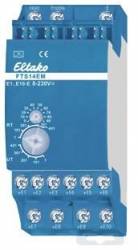Eltako FTS14EM - pushbutton input module RS485 bus BR14 30 014 060
Installation > Home Automation > EIB material

Eltako FTS14EM - pushbutton input module RS485 bus BR14 30 014 060
| Lieske Part No. | 294718 |
|---|---|
| Mfg Part No | 30014060 |
| EAN-Code | 4010312315071 |
| Manufacturer | Eltako |
| Here only | 68,21 EUR
81,17 EUR incl. VAT
|
Further information for Eltako FTS14EM - pushbutton input module RS485 bus BR14 30 014 060
Input module for the Eltako RS485 bus, 10 control inputs for universal control voltage. Standby loss only 0.1 watts. Modular device for mounting on DIN-EN 60715 TH35 mounting rail. 2 division units = 36mm wide, 58mm deep. Connection to the Eltako RS485 bus. Cross-wiring of bus and power supply with jumpers. Operation in conjunction with FAM14 or FTS14KS. 10 control inputs +E1..+E10/-E galvanically isolated from the supply voltage. Control voltage: 8..230V UC. The control inputs can be activated either for buttons (delivery status), window-door contacts or motion detectors. From production week 21/19, the signals of the control inputs can be inverted. Control inputs for buttons: Telegrams from radio buttons are generated (e.g. 0x70). Each FTS14EM can be set to either UT (= universal button) or RT (= direction button) using the lower rotary switch. Control inputs for window-door contacts: Telegrams from the FTK radio window-door contact are generated (EEP D5-00-01). If the input is controlled by the contact with the externally applied control voltage, the window closed telegram is generated. If the contact is opened, the window open telegram is generated. As with the FTK radio sensors, the status telegram is repeated every 15 minutes. Control inputs for motion detectors: Telegrams from the FBH radio motion-brightness sensor are generated (EEP A5-08-01), whereby the brightness value is always 0. If the input is controlled by the contact with the externally applied control voltage, the movement telegram is generated. If the contact is opened, the no movement telegram is generated. As with the FBH radio sensors, the status telegram is repeated every 15 minutes. Each telegram of a contact input must be taught in with an identification number (ID) in one or more actuators according to their operating instructions. The lower rotary switch determines which group an FTS14EM belongs to. A total of 5 groups (1, 101, 201, 301, and 401) with 100 IDs each are available. The ID within a group is set on the upper rotary switch (0..90). The ID range within a group results from the combination of the lower and upper rotary switches and must be set differently on each FTS14EM. A maximum of 10 FTS14EMs form a group. In total, a maximum of 50 FTS14EMs with 500 buttons or contacts are possible in an RS485 bus. In order to generate the necessary learning telegrams for teaching in the actuators, the desired group must be selected on the upper and lower rotary switches. For buttons in the UT or RT range or for window-door contacts and motion detectors in the RT range. Then activate the desired control input. During operation, the same group must then be selected in the UT or RT range for buttons or UT for window-door contacts and motion sensors. The LED under the upper rotary switch flashes briefly,when a connected contact is closed. Optional: A FAM14 radio antenna module from the building radio system that is only two pitch units wide can also be installed, which means that the actuators can then be controlled not only by the conventional buttons and contacts via the FTS14EM but also with radio buttons, handheld transmitters and radio sensors. Since the FAM14 has an integrated switching power supply, the FTS14KS for power supply is not required in this installation. The bidirectional FAM14 also makes it possible to evaluate feedback from the actuators via radio from the SafeIV smart home control center. The respective status of the actuators can thus be displayed and also changed. The connection of the HOLD terminals of all devices regulates bus access and prevents collisions. With the optional FTS14FA radio output module, the telegrams from the FTS14EM can also be sent to the Eltako building radio system.

This is an offer of:
79279 Vörstetten
http://industry-electronics.com
Tel. 07666/88499-0
Fax. 07666/88499-111
Diesen Artikel finden Sie unter:
industry-electronics.com/artikel/294718

Lieske Elektronik e.K.
Reutener Str. 1079279 Vörstetten
http://industry-electronics.com
Tel. 07666/88499-0
Fax. 07666/88499-111
Diesen Artikel finden Sie unter:
industry-electronics.com/artikel/294718
